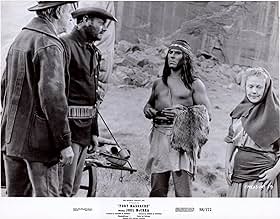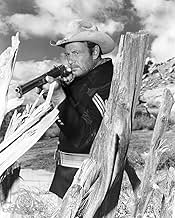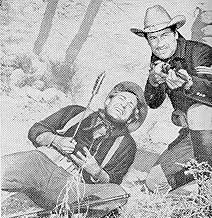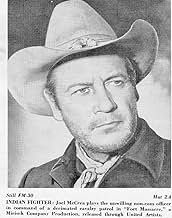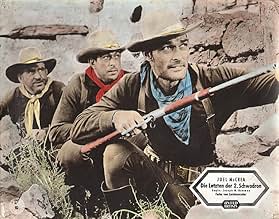Fort Massacre
- 1958
- Tous publics
- 1h 20m
IMDb RATING
6.2/10
1.2K
YOUR RATING
A cavalry troop finds itself under constant attack by Indians.A cavalry troop finds itself under constant attack by Indians.A cavalry troop finds itself under constant attack by Indians.
Francis McDonald
- Piute Man
- (as Francis J. McDonald)
John Fritz
- Apache Indian
- (uncredited)
Bernie Gozier
- Apache Indian
- (uncredited)
Walter Kray
- Chief
- (uncredited)
Ben Rombouts
- Apache Indian
- (uncredited)
- Director
- Writer
- All cast & crew
- Production, box office & more at IMDbPro
Featured reviews
You know you have a great action film when you realize you could make it work just as well as a stage play.
And that's what we have here. An action Western about a "lost patrol" style cavalry unit, against the natives.
Don't be misled by the "action" though. This is a deep story. McCrea gives an astounding performance, owed also to great writing, directing, and supporting cast, as a man who isn't what he seems.
The movie gives us a look at how a man in position of leader can seem to be in one piece, but isn't. We see hints of the character's madness, and some, like Tucker's character, have seen him enough not to be fooled. A pair of peaceful Indians, one an old man, the other a beautiful woman, become pivotal in learning more about McCrea, and pivotal in his sole supporter's realization of how mad his leader is.
The two Indians are exceptionally well written, and played to perfection. We see two humans, and so does the cavalry unit, all except McCrea.
The ending is quite a surprise, even today. Very few cavalry films show characters who are this believable and three dimensional.
And that's what we have here. An action Western about a "lost patrol" style cavalry unit, against the natives.
Don't be misled by the "action" though. This is a deep story. McCrea gives an astounding performance, owed also to great writing, directing, and supporting cast, as a man who isn't what he seems.
The movie gives us a look at how a man in position of leader can seem to be in one piece, but isn't. We see hints of the character's madness, and some, like Tucker's character, have seen him enough not to be fooled. A pair of peaceful Indians, one an old man, the other a beautiful woman, become pivotal in learning more about McCrea, and pivotal in his sole supporter's realization of how mad his leader is.
The two Indians are exceptionally well written, and played to perfection. We see two humans, and so does the cavalry unit, all except McCrea.
The ending is quite a surprise, even today. Very few cavalry films show characters who are this believable and three dimensional.
Joel McCrea stars as tough US Cavalry Sergeant Vinson, who has to take command of "C Troop" when the senior officers are killed during an Apache attack. But what drives Vinson on? And is he the right man to lead the remaining members of the Troop? Directed by Joseph Newman, the films photography comes from Carl Guthrie, screenplay is courtesy of Martin Goldsmith, it's filmed in CinemaScope with De Luxe colour and the co- star list contains Forrest Tucker, John Russell, George N. Neise & Susan Cabot.
A moody and tough psychological Western that showcases the truly good side of the "B" Western splinter. Thematically strong with its anti-racist core, and really tightly written by Goldsmith, it's also notable for containing a wonderful performance from McCrea. Though his Western output was very hit and miss (the brilliant Peckinpah film "Ride The High Country" was to come 4 years later) McCrea was always value for money in even the tardiest of Oaters. Here he gets to really grizzle for all his worth, his Vinson is a bitter man, blinded by hate, yet still capable of softening up if engaged in the right conversation. McCrea is first rate in the role, never over doing the hard-nosed side of the character and garnering believable sympathy when his guard is down.
More known for being the director of "This Island Earth", Joseph Newman is hardly the name one links to the direction of a psychological Western. Yet he does a surprisingly good job with the action sequences and rightly lets his actors just tell the story. There's a small complaint that the final battle is all too brief, but that's a touch offset by a hillside C Troop/Apache battle that takes place in the first third of the film. Briskly constructed and with no saggy male posturing to weigh it down, the battle shows Newman to be quite adept at crafting a good old fashioned fight to the death between two very old fashioned foes. The film also looks terrific. Though sadly not having a widespread DVD release and therefore not getting a remastered work over, the current print of the film available to television networks and Region 1 DVD is still a treat in this High Definition age. Where once the print was apparently murky, you now should be able to adjust and reap the benefit of what is on offer. Filmed at three locations, Gallup/New Mexico, Red Rock State Park/New Mexico & Kanab/Utah, Carl Guthrie's photography really utilises these locations, one moment it be a beautiful sprawling landscape, the next the rocks are enveloping the characters to portray the tension and confinement of their emotional and physical journey. All given the De Luxe sheen as the browns, reds and uniform blues come vividly to life.
Fort Massacre is little known and certainly under seen, thus its reputation has been founded by the casual Western viewer entering into it unaware of what type of character driven film it is. It's hoped that it can now find a newer and more appreciative audience because it's one of the better "B" Westerns of the late 1950s. 8/10
A moody and tough psychological Western that showcases the truly good side of the "B" Western splinter. Thematically strong with its anti-racist core, and really tightly written by Goldsmith, it's also notable for containing a wonderful performance from McCrea. Though his Western output was very hit and miss (the brilliant Peckinpah film "Ride The High Country" was to come 4 years later) McCrea was always value for money in even the tardiest of Oaters. Here he gets to really grizzle for all his worth, his Vinson is a bitter man, blinded by hate, yet still capable of softening up if engaged in the right conversation. McCrea is first rate in the role, never over doing the hard-nosed side of the character and garnering believable sympathy when his guard is down.
More known for being the director of "This Island Earth", Joseph Newman is hardly the name one links to the direction of a psychological Western. Yet he does a surprisingly good job with the action sequences and rightly lets his actors just tell the story. There's a small complaint that the final battle is all too brief, but that's a touch offset by a hillside C Troop/Apache battle that takes place in the first third of the film. Briskly constructed and with no saggy male posturing to weigh it down, the battle shows Newman to be quite adept at crafting a good old fashioned fight to the death between two very old fashioned foes. The film also looks terrific. Though sadly not having a widespread DVD release and therefore not getting a remastered work over, the current print of the film available to television networks and Region 1 DVD is still a treat in this High Definition age. Where once the print was apparently murky, you now should be able to adjust and reap the benefit of what is on offer. Filmed at three locations, Gallup/New Mexico, Red Rock State Park/New Mexico & Kanab/Utah, Carl Guthrie's photography really utilises these locations, one moment it be a beautiful sprawling landscape, the next the rocks are enveloping the characters to portray the tension and confinement of their emotional and physical journey. All given the De Luxe sheen as the browns, reds and uniform blues come vividly to life.
Fort Massacre is little known and certainly under seen, thus its reputation has been founded by the casual Western viewer entering into it unaware of what type of character driven film it is. It's hoped that it can now find a newer and more appreciative audience because it's one of the better "B" Westerns of the late 1950s. 8/10
FORT MASSACRE (1958) takes a standard "lost patrol" war movie plot and adapts it to 1879 New Mexico and a tale of remnants of an embattled cavalry platoon who have to make it through hundreds of miles of hostile desert terrain while fighting off roving bands of Apaches. It's a harsh, gritty take on the subject, uncompromising and fairly unpredictable. It has a tough, grizzled, nearly all-male cast, led by Joel McCrea as a Sergeant forced to take command after all the superior officers have been killed. The members of the platoon gripe and take issue with McCrea over the risks he makes them take, including the decision to attack a large band of Apaches who've taken over a needed waterhole. McCrea is driven by a hatred of the Apaches, who'd killed his wife, and his men are concerned that his emotions are coloring his decision making.
It's well-told, gripping, and expertly photographed (by Carl Guthrie) entirely on location. The climax takes place in an abandoned Indian cliff dwelling. It also has a particularly strong cast. In addition to McCrea, the chief soldier characters include Forrest Tucker (TV's "F Troop") as an Irishman who makes light of everything but is especially hostile to McCrea; John Russell (TV's "The Lawman") as a son of privilege who joined the army to find himself; and veteran character actor Anthony Caruso, as Pawnee, a seasoned Indian scout. The other soldiers include Denver Pyle (BONNIE AND CLYDE), Robert Osterloh (WHITE HEAT), and Rayford Barnes (THE WILD BUNCH). Also in the cast are third-billed Susan Cabot (THE WASP WOMAN) in a small role as a Paiute Indian girl hiding out in the cliff dwelling with her grandfather, Francis L. McDonald (NORTHWEST MOUNTED POLICE). Comic character actor Irving Bacon (the BLONDIE series) pops up as a shady trader who puts the Cavalrymen in danger.
It's a consistently suspenseful film with regular bursts of action, including two major gun battles with the Apaches. The action is never contrived and plays out in a believable fashion throughout, with no last-minute rescues or superhuman actions by the cavalrymen. The men behave in an authentic fashion and one can see this film as a respectable echo of earlier war-themed lost patrol movies, including Samuel Fuller's THE STEEL HELMET and Anthony Mann's MEN IN WAR. The ending is quite surprising. The script is by Martin M. Goldsmith (DETOUR) and the film was directed by Joseph Newman (PONY SOLDIER, THIS ISLAND EARTH).
The cinemascope photography suffers considerably from the murky color print which ran in a full-frame presentation on Superstation TBS which didn't even bother to pan and scan. As a result, group shots of the men debating plans of action frequently feature off-camera speakers. This is one of many unsung westerns from the 1950s that would benefit greatly from a letter-boxed remastered DVD edition enabling it to be re-discovered by western fans.
It's well-told, gripping, and expertly photographed (by Carl Guthrie) entirely on location. The climax takes place in an abandoned Indian cliff dwelling. It also has a particularly strong cast. In addition to McCrea, the chief soldier characters include Forrest Tucker (TV's "F Troop") as an Irishman who makes light of everything but is especially hostile to McCrea; John Russell (TV's "The Lawman") as a son of privilege who joined the army to find himself; and veteran character actor Anthony Caruso, as Pawnee, a seasoned Indian scout. The other soldiers include Denver Pyle (BONNIE AND CLYDE), Robert Osterloh (WHITE HEAT), and Rayford Barnes (THE WILD BUNCH). Also in the cast are third-billed Susan Cabot (THE WASP WOMAN) in a small role as a Paiute Indian girl hiding out in the cliff dwelling with her grandfather, Francis L. McDonald (NORTHWEST MOUNTED POLICE). Comic character actor Irving Bacon (the BLONDIE series) pops up as a shady trader who puts the Cavalrymen in danger.
It's a consistently suspenseful film with regular bursts of action, including two major gun battles with the Apaches. The action is never contrived and plays out in a believable fashion throughout, with no last-minute rescues or superhuman actions by the cavalrymen. The men behave in an authentic fashion and one can see this film as a respectable echo of earlier war-themed lost patrol movies, including Samuel Fuller's THE STEEL HELMET and Anthony Mann's MEN IN WAR. The ending is quite surprising. The script is by Martin M. Goldsmith (DETOUR) and the film was directed by Joseph Newman (PONY SOLDIER, THIS ISLAND EARTH).
The cinemascope photography suffers considerably from the murky color print which ran in a full-frame presentation on Superstation TBS which didn't even bother to pan and scan. As a result, group shots of the men debating plans of action frequently feature off-camera speakers. This is one of many unsung westerns from the 1950s that would benefit greatly from a letter-boxed remastered DVD edition enabling it to be re-discovered by western fans.
It has been years since I have seen this movie and I have been looking for it for a long time. I still remember moments in the movie as if I just saw it yesterday because of its gripping mature story line and deep rich character portrayals. I still get goosebumps when I think about it. The plot development was powerful with what I found to be a shocking conclusion. I find classic story telling with intense character portrayals to be much more interesting than some of the movie gimmicks used by most of the industry today. This movie is not shy on realism or story. I guess that some of that which makes up the high quality depth of this motion picture story simply goes over the head of some people, (based on some of the other reviews I have read about this film). I believe this is an absolute must see for McCrea or Russell fans.
A good Western with McCrea as an army sergeant with a severe chip on his shoulder -- his family was killed by American Indians. When the detachment he serves in is attacked, all his superiors are killed and he has to take command of the survivors -- who believe his bigotry will lead them into confrontations which are unnecessary.
McCrea is very good at playing the sergeant as a kind of ruined idealist, beating Wayne at his own game. He has a good rapport with Russell, who plays a man more or less in between the two factions -- he's attached to his sergeant, but can see that his hatred may lead them into danger. Cabot also appears as a native woman, but is not given much to do except be the unwarranted object of McCrea's hatred and suspicions.
A satisfying action film with a strong anti-racist message.
McCrea is very good at playing the sergeant as a kind of ruined idealist, beating Wayne at his own game. He has a good rapport with Russell, who plays a man more or less in between the two factions -- he's attached to his sergeant, but can see that his hatred may lead them into danger. Cabot also appears as a native woman, but is not given much to do except be the unwarranted object of McCrea's hatred and suspicions.
A satisfying action film with a strong anti-racist message.
Did you know
- TriviaFinal film of Irving Bacon. For the remainder of his career he acted on television.
- GoofsForrest Tucker's Irish accent constantly comes and goes throughout the movie.
- Quotes
[Vinson's cavalry patrol hurriedly buries a dead trooper]
Sgt. Vinson: Collins, that's deep enough. Roll him in and cover him up. Let's move!
Pvt. Collins: You mean without reading the Good Book?
Sgt. Vinson: If he needs our help to make it upstairs, he's in worse shape than he looks.
- ConnectionsFeatured in Sven Uslings Bio: Fort Massacre (2020)
- How long is Fort Massacre?Powered by Alexa
Details
- Runtime1 hour 20 minutes
- Sound mix
- Aspect ratio
- 2.35 : 1
Contribute to this page
Suggest an edit or add missing content



